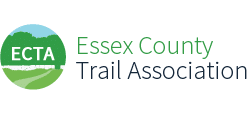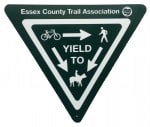With the popularity of outdoor activities rising on our limited open space, trail etiquette is becoming increasingly important. Although there are still many bridle trails in our area that are limited to equestrian use, most trails are multi-use and are open to hikers, runners, dog-walkers, cyclists, cross-country skiers and equestrians. While our modes of trail use differ, we all share a love of the trails and open spaces that we are privileged to enjoy. Please review the following trail etiquette tips so that all trail users may have a safe and enjoyable experience!
1. Be Courteous: All trail users should be respectful of others, regardless of their mode, speed or level of skill. This is particularly important when crossing private property. The person you are passing could be a landowner or one of their friends!
2. Slow Down: If you are approaching another trail user, or can’t see around a bend in the trail, you need to slow down. You are not the only person on the trail. Traveling at high speeds on bikes or horseback should only be done where it is safe and others can easily see you coming.
4. Announce Your Presence: If you are coming up from behind, ALWAYS announce to the person in front of you if you plan to pass them. Wait for them to respond before passing. Start with a friendly voice level, but you may need to raise your voice if they are wearing headphones or you don’t get a response. If you are approaching horses from any direction, it is always a good idea to say hello, and to keep a conversation going until horse and rider have passed. A talking helmet or backpack is much less intimidating than a silent one!
5. Yield to Oncoming Traffic: Bicyclists must yield to pedestrians and equestrians. Pedestrians also yield to equestrians. All trail users need to slow to a safe speed – approaching at a walk is recommended, but as long as both of you acknowledge each other you should be able to cross paths at a moderate pace. If there is room to safely share the trail you can pass left should to left shoulder. If it is a narrow trail, the yielding trail user should move off of the trail on the downhill side.
6. Pass Safely: The trail user being overtaken should acknowledge the passer by moving to the right side of the trail (if there is room to safely pass), or by stopping and moving off of the trail. Horses can easily be spooked by another trail user coming up behind them, and will sometimes kick out of self-defense. Equestrians being passed should stop and turn their horse’s head and body perpendicular to the trail when possible. If there is not room to safely move off of the trail, the passer will need to wait until the person ahead can get to a more open area on the trail. Always pass at a safe speed.
7. Yield on the Downhill: In steep areas, traffic heading uphill has the right of way. It is more difficult for uphill trail users to stop and then regain their momentum. That being said, common sense should always prevail. For example, if one uphill hiker encounters ten downhill bikers, it would make more sense for the hiker to step off the trail to let the larger group pass.
8. Don’t Block the Trail: Be aware of other trail users approaching and always make sure there is room for them to pass. When possible, try to stop in an area where you do not have to move off of the trail and damage sensitive vegetation.
9. Be Predictable: Travel at a consistent pace and make sure you are visible to other trail users. If you are constantly changing speeds it will make it difficult for others to pass.
10. Obey All Trail Signage: It is extremely important to stay on existing, open trails only. There is usually a very good reason why a trail is closed or limited to certain trail users, and most of the time it is for your safety! DO NOT create new trails without authorization from the land owner and proper permits from the Conservation Commission.
11. Pick Up trash: If you bring it in, take it out. If you see trash along the trail, help keep the trails clean by picking it up. For dog owners, PLEASE be sure to pick up your poop – this is especially important in reservoir areas that may close to dogs if owners are not picking up after their pet. For riders, be aware of the rules on picking up horse manure – generally this is limited to the parking area, but the Rail Trail also requests that manure be removed from the trail.
12. Keep the Volume Down: If you wear headphones, make sure that they are set low enough that you can hear other trail users. If you are with others, try to keep your voices to a reasonable level so you don’t disturb other trail users out enjoying the quiet or observing wildlife.
13. Be Aware of Conditions: Look down – if you are leaving tire ruts, hoof prints or deep footprints on the ground, then the footing is too soft and you are damaging the trail. Move to trails on drier ground, or avoid the trails altogether until conditions improve.
14. Know the Leash Law: Be sure to check whether or not certain properties allow dogs, and also what their rules are for off-leash pets. You should be able to see and be in control of your dog at all times and be able to call them back so they do not approach other trail users. A loose dog can easily startle a horse and can be kicked if they get too close. Equestrians should leave dogs at home when hitting the trails on horseback.
With the number of equestrians in our area, encounters with horses are common. Because they can react unpredictably when startled, horses do have the right of way on the trails. If you see a horse acting up as you approach, stop and stand still until the rider indicates it is safe for you to proceed. Riders should be respectful and courteous of all other trail users, and thank them for their consideration in these situations.
Organized trail events occur throughout the year on both public and private trails. If you encounter a race or event in progress, please be respectful of competitors and grant them the right of way on the trails. Try to determine the race route and avoid those areas. ECTA issues Trail Alerts to notify our members of event locations.
Trail users should also be aware that fox hunting occurs several times during the week from April – June and August – November throughout our area. Riders have to keep up with the hounds when they are working a line of scent (in our area there is no live hunting, only a drag scent), which means that riders may be galloping in a group of anywhere from 10 to 100 horses. If you hear the hounds or horn, be on alert. If you see the hounds coming in your direction, move off to the side of the trail and find a safe place where the following group of horses can easily pass by you. Please visit the Myopia Hunt website at www.myopiahunt.org for more information and their schedule.
By knowing these rules of trail etiquette, we should all be able to safely share the trails. To find out more information on trail regulations and restrictions for specific properties, please visit our website at www.ectaonline.org.

